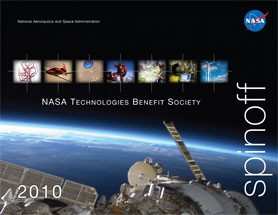Thu, Dec 23, 2010
Annual Document Outlines Impact Of Space Technology In Our
Daily Lives
 Curious how a device designed to produce fuel and oxygen on
Mars transformed into a source of clean energy right here on Earth?
The 2010 edition of NASA's annual Spinoff publication is now
available online, highlighting new innovations and notable examples
of NASA technology improving everyday life on our home planet.
Curious how a device designed to produce fuel and oxygen on
Mars transformed into a source of clean energy right here on Earth?
The 2010 edition of NASA's annual Spinoff publication is now
available online, highlighting new innovations and notable examples
of NASA technology improving everyday life on our home planet.
Spinoff provides an in-depth look at how the agency's
initiatives in aeronautics and space exploration have resulted in
beneficial commercial technologies in the fields of health and
medicine, transportation, public safety, consumer goods,
environmental protection, computer technology, and industrial
productivity. These advancements enhance our quality of life while
contributing to the nation's economy through the creation of jobs
and the support of businesses, large and small. They also help to
inspire younger generations to explore education and careers in
science, technology, math, and engineering.
"Through NASA's work with its commercial partners, technologies
that are helping us explore our universe are now also saving lives,
preserving our environment and enhancing our nation's
transportation and security," said Bobby Braun, chief technologist
at NASA Headquarters in Washington. "Since 1976, NASA's Spinoff
publication has documented more than 1,700 compelling examples of
NASA research and innovation that benefit the public every
day."

Spinoff 2010 contains dozens of examples highlighting how space
technology yields innovations with Earthly benefits,
including:
- Algorithms developed by a NASA researcher that are enabling
technology for medical diagnosis and prediction of brain blood
flow-related conditions such as stroke, dementia, and traumatic
brain injury.
- NASA-proven, drag-reducing wing modifications that have already
saved commercial airlines more than 2 billion gallons in jet
fuel
- Inflatable antennas -- developed with NASA funding -- that
support essential communication needs in remote areas during
military operations, as well as in disaster zones.
- Image sensors, invented by a NASA team, that are now featured
in one out of every three cell phone cameras
- A groundwater remediation compound, created by NASA to treat
contaminated launch facilities, now being used to clean up polluted
areas around the world.
Spinoff also profiles NASA's research and development
activities, education efforts and partnership successes for the
year. This edition celebrates the 10th anniversary of continuous
habitation onboard the International Space Station, revealing the
many ways that technologies developed for the space station have
resulted in public benefits on Earth.
More News
19-Year-Old Pilot Was Attempting to Fly Solo to All Seven Continents On his journey to become the first pilot to land solo on all seven continents, 19-year-old Ethan Guo has hit a >[...]
From 2017 (YouTube Edition): A Quality LSA For Well Under $100k… Aeroprakt unveiled its new LSA at the Deland Sport Aviation Showcase in November. Dennis Long, U.S. Importer>[...]
Hazardous Weather Information Summary of significant meteorological information (SIGMET/WS), convective significant meteorological information (convective SIGMET/WST), urgent pilot>[...]
Aero Linx: Historic Aircraft Association (HAA) The Historic Aircraft Association (HAA) was founded in 1979 with the aim of furthering the safe flying of historic aircraft in the UK>[...]
"We would like to remember Liam not just for the way he left this world, but for how he lived in it... Liam was fearless, not necessarily because he wasn't afraid but because he re>[...]
 TikToker Arrested After Landing His C182 in Antarctica
TikToker Arrested After Landing His C182 in Antarctica Classic Aero-TV: Versatile AND Practical - The All-Seeing Aeroprakt A-22 LSA
Classic Aero-TV: Versatile AND Practical - The All-Seeing Aeroprakt A-22 LSA ANN's Daily Aero-Term (06.27.25): Hazardous Weather Information
ANN's Daily Aero-Term (06.27.25): Hazardous Weather Information ANN's Daily Aero-Linx (06.27.25)
ANN's Daily Aero-Linx (06.27.25) Aero-News: Quote of the Day (06.27.25)
Aero-News: Quote of the Day (06.27.25)




